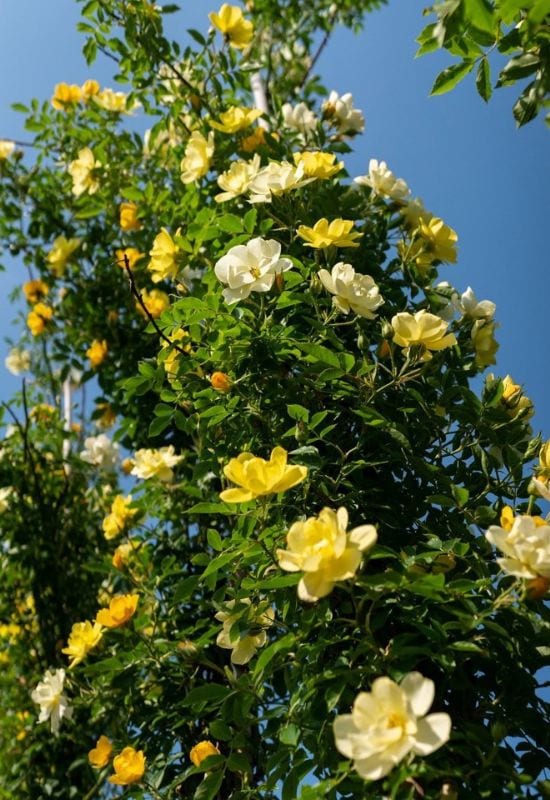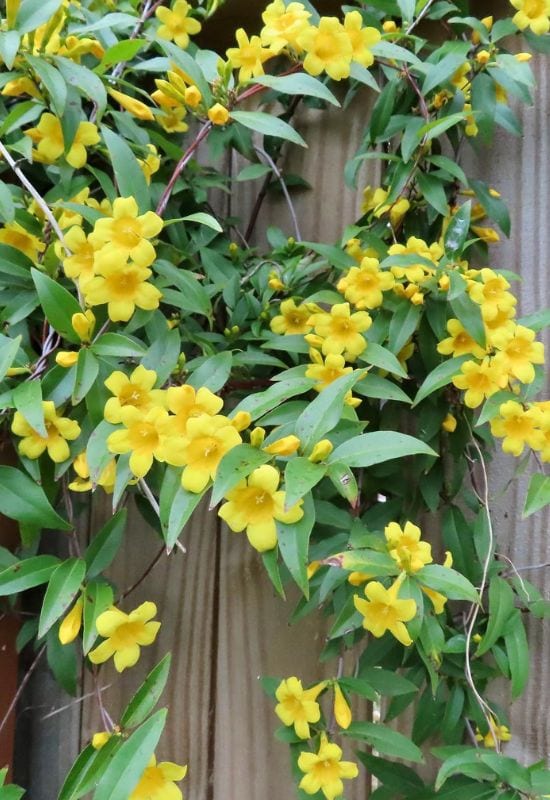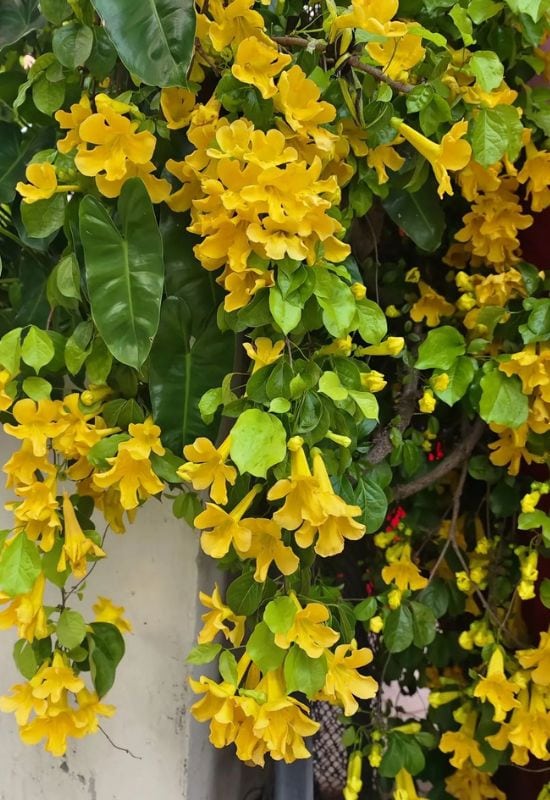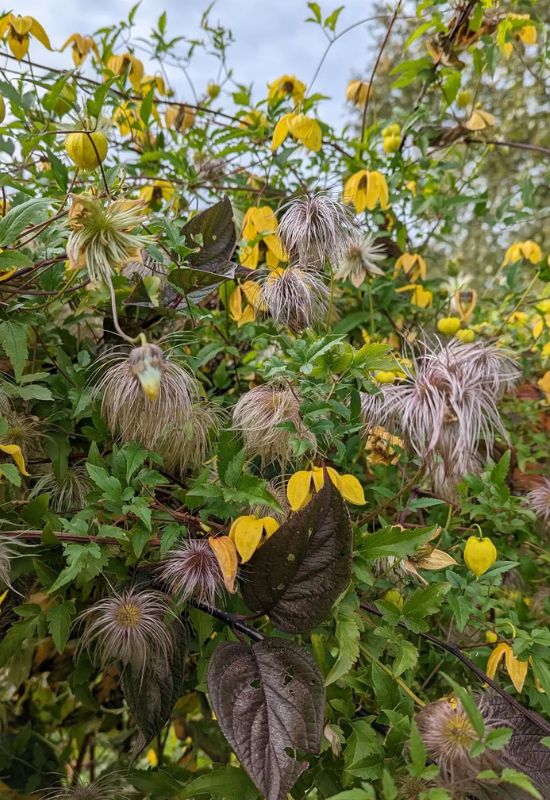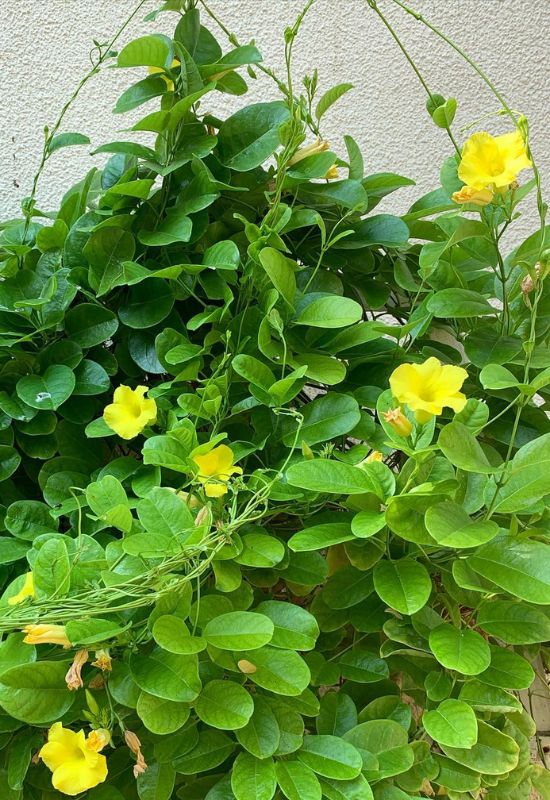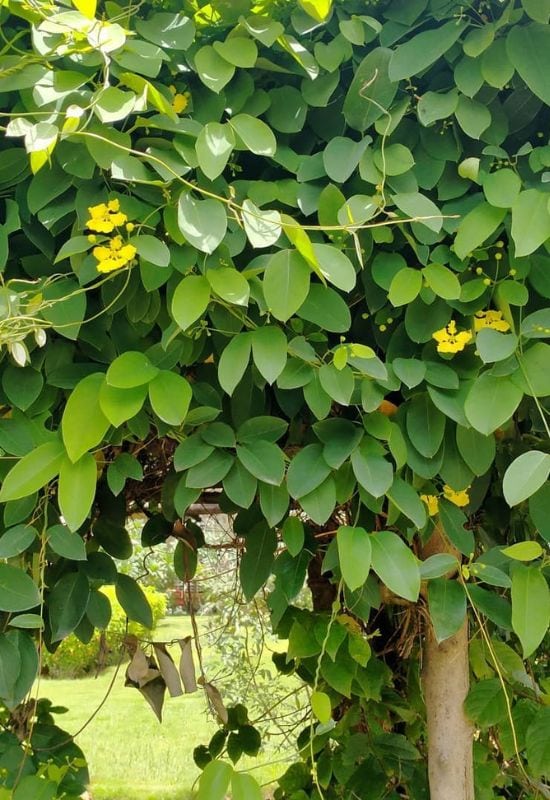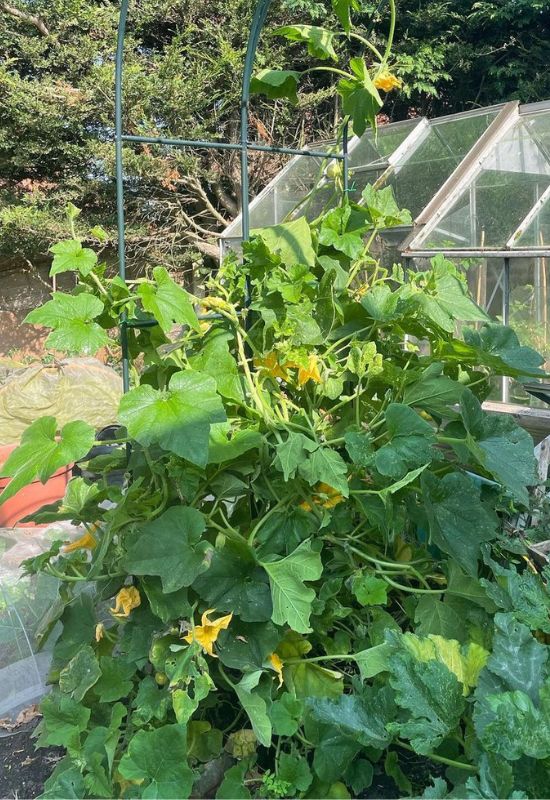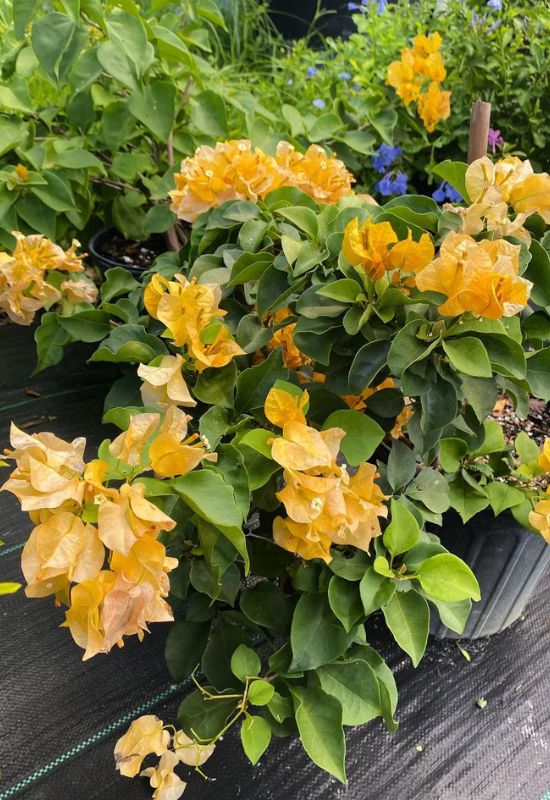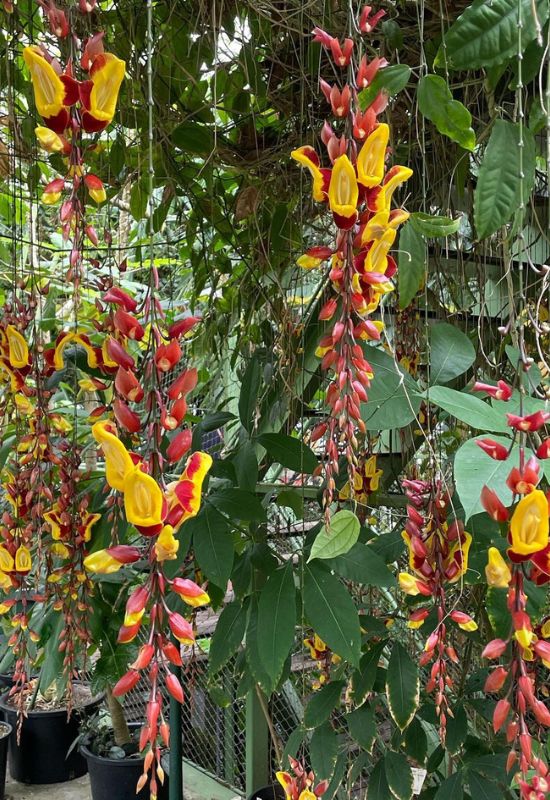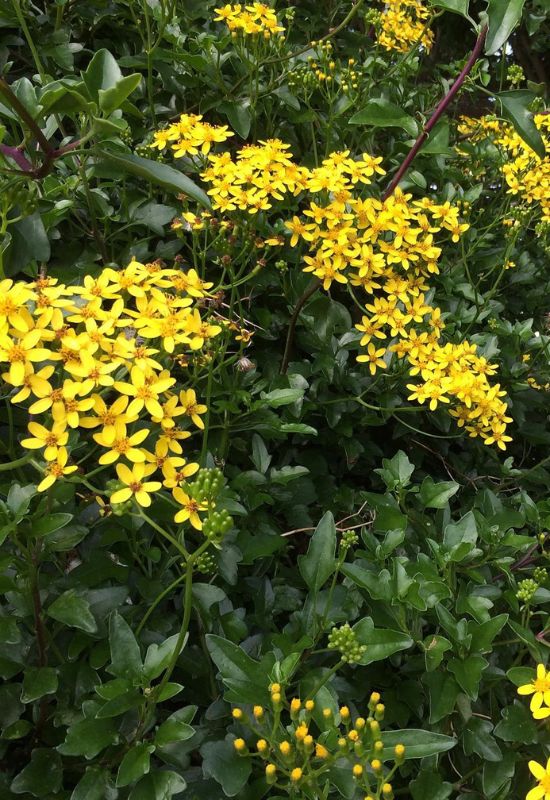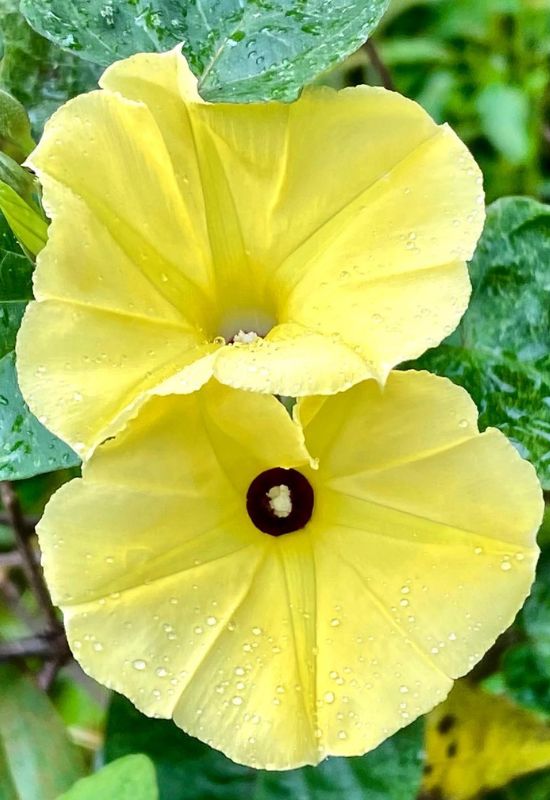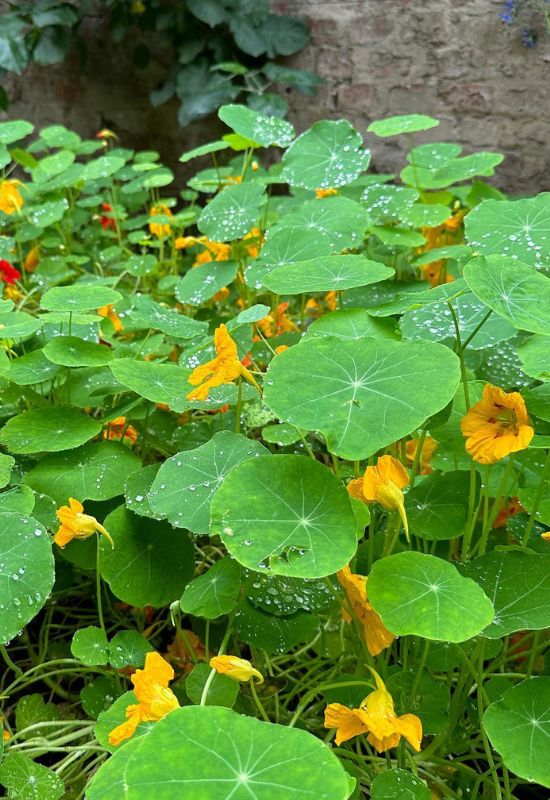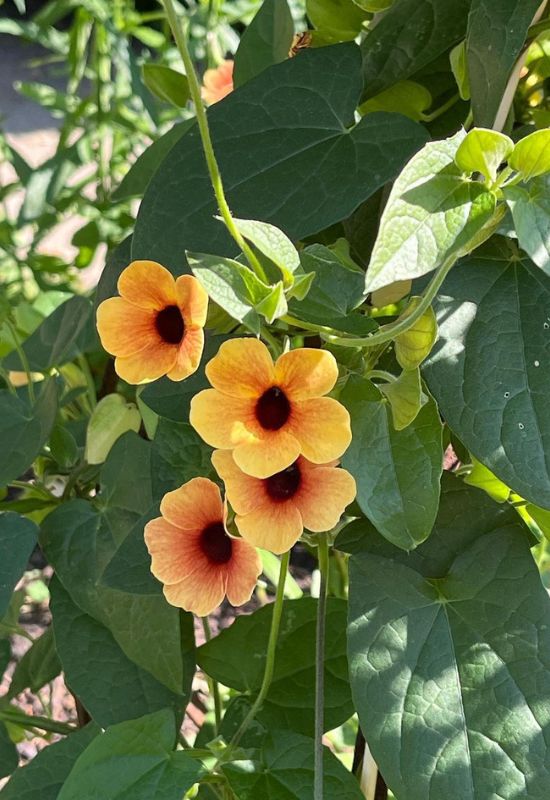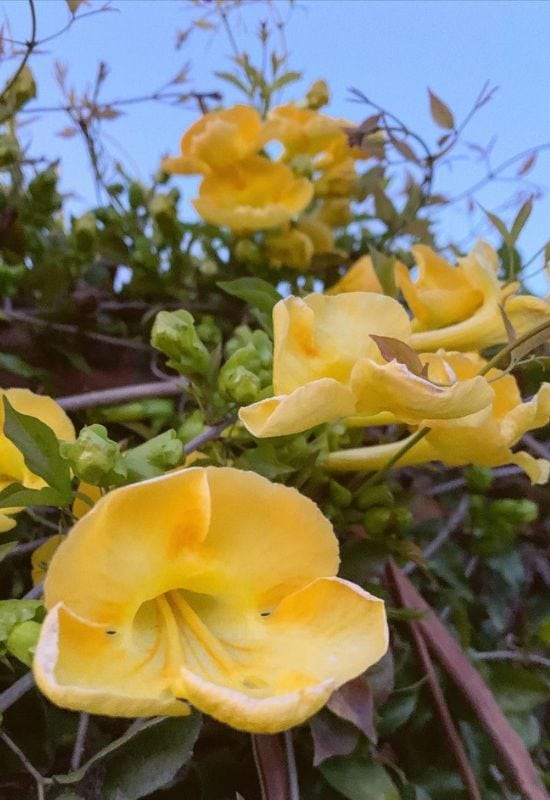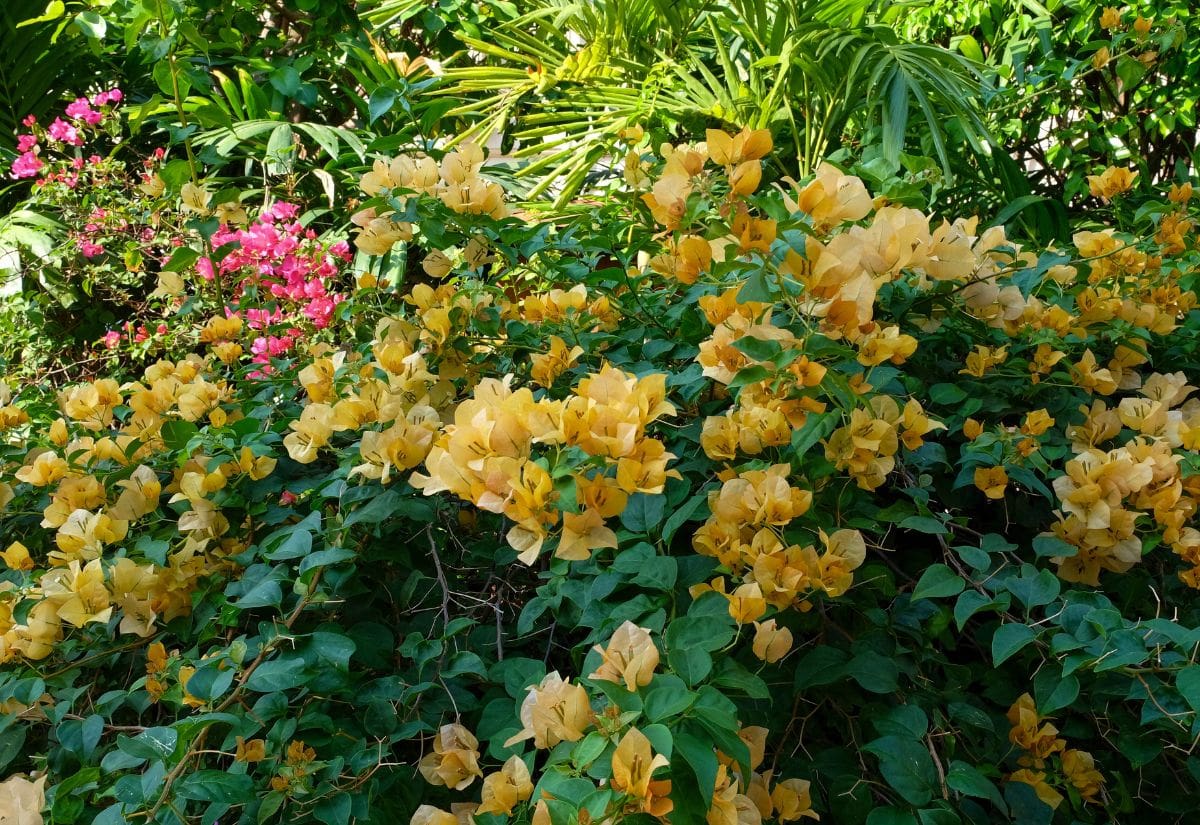
Grow a garden where the Sun never sets! Yes, just picture golden, saffron and canary yellow blossoms hanging on vines, wavingamong the green foliage with their energy and light.
Imagine your fence flaring up with brightly colored blooms in shades of corn, pineapple or bumblebee… Now, turn to your gazebo, harbor, or even the walls of your house… And, again, paint them with the fresh color of leaves and the vibrant life force of flowers in the warm color of sunny summer days!
Talking of seasons, there are climbing and vining varieties that blossom in any season, including winter, and many evergreen ones too.
This way, your garden will never be dull, lifeless or lackluster – on the contrary, you can drape it and soften structures and edges, while at the same time sparking up a flame with the color of sunlight itself!
The most decorative flowering vines and climbers with yellow blooms are waiting for you right now, here beneath, and there are varieties for all tastes, exotic or gentle, for cold and warm climates, for rainy or dry land…
15 Climbing Vines with Brilliant Yellow Blossoms
If you look around, you will find very few varieties of vining plants with golden yellow flowers, but we managed to find quite a few:
And the first vine with yellow flowers is a real golden queen, just to give you an idea of what to expect!
1: ‘Golden Gate’ Climbing Rose (Rosa ‘Golden Gate’)
How could we start, if not with the undisputed queen of all gardens, a rose? And ‘Golden Gate’ is a climbing variety that deserves a special place on our list…
Rising up above your head to about 8 feet (2.4 meters) this winner of the Award of Garden Merit by the Royal Horticultural Society has fully double flowers that reach about 3.3 inches across (8.0 cm), and each can have up to 6 dented petals.
The blooms start off on the golden range of yellow, but they pale to butter and cream when they mature… Yet another attractive quality of this climber is that its blossoms have a very peasant fruity fragrance with strong notes of coconut and citrus…
Flowering for a long time from early summer into fall, it will produce eye catching (and edible) shiny red hips that persist till late un the season. And this final display is wonderfully set off by the semi glossy, deep green and almost leathery foliage, which is also fairly healthy for a rose!
Bred by Tim Hermann Kordes in 1995, ‘Golden Gate’ climbing rose has become a very popular garden variety to grow on trellises, porches, harbors and, of course, gates! The important thing is that you give it a prominent place, because it is a show stopper!
2: Carolina Jessamine (Gelsemium sempervirens)
Let me prove the point I made in the introduction… And I will do it showing you Carolina jessamine, an evergreen twining climber native to the south of the USA and Guatemala…
In fact, this vine will blossom in winter (and continue into spring), bringing you the light and energy of the Sun when your garden most need them!
The blossoms are trumpet shaped, about 3 inches across (7.5 cm) and coming profusely in terminal clusters!
Their color is golden yellow, and you could see dashes of orange towards the tips of the margins… Loved by butterflies, bees and hummingbirds, it can also be pruned into a bushy shrub if you wish.
Yes, this is because the foliage is also very dense, and very attractive indeed! The leaves are about 3 inches long (7.5 cm), ovate and glossy, deep green throughout the year, but they take on copper shades in the cold season.
Finally, it is also a recipient of the coveted Award of Garden Merit by the Royal Horticultural Society.
As long as you protect Carolina Jessamine from cold winds, you can have its golden blossoms and lush leaves drape any wall, fence, gate or pergola in your garden, even in shady spots, and its energy will certainly light up your days!
3: Yellow Trumpet Vine (Campsis radicans f. flava)
Here’s yet another climber with richly colored blossoms for your garden, but this time they will lighten up your garden in mid season: yellow trumpet vine! The flowers are, of course, trumpet shaped and they open at the mouth splitting into five broad and roundish petals, giving you a very soft look.
About 3.3 inches long (8.0 cm), these blossoms come in lush clusters and they complement their mellow shape with a very warm tonality of yellow, on the honey range, and in some cases, they can even take on peach blushes!
What is more, their long and narrow structure makes them favorites of hummingbirds, that will come to feed on them more than willingly. When the floral display is over, long and decorative bean like seed pods will follow, for interest in the fall.
Yet another great asset of this tall climbing beauty from North America is the luxurious, rich green pinnate leaves that give extra texture as well. Surprise, surprise, this variety is also a winner of the Award of Garden Merit by the Royal Horticultural Society!
Ideal for tall walls, arbors, trellises and fences, yellow trumpet vine is also easy to trim, so you could grow it in a small garden as well, and it is suitable to informal styles that range from tropical and exotic to cottage and traditional!
4: ‘Bill MacKenzie’ Clematis (Clematis orientalis var. tangutica ‘Bill MacKenzie’)
Clematis is one of the most popular climbers in gardens all over the world, and it is famous for its purples, violets, blues etc. But few people know that it can also produce flowers in the color of gold!
In fact, the tanguticavariety has yellow blooms, and its cultivar ‘Bill MacKenzie’ is a vining champion, having received the Award of Garden Merit by the Royal Horticultural Society…
The floral show will start in mid summer and continue into the gall, with yellow blossoms that look like globes, or lanterns when they start to open.
As they mature, they form nodding bells, and then they finally stretch their petals out, revealing very dark stamens in the center… The overall size is about 3 inches across (7.5 cm). But this will not end their spectacle.
In fact, it will be followed by fluffy pompons of silky filaments that persist till late in the season, and they glisten in the sunlight! It is also noted for the foliage, which is mid green but also finely cut, giving you texture and a delicate look
Fast growing and tall, ‘Bill MacKenzie’ clematis is also quite cold hardy and shade tolerant, and suitable to hide tall walls, or in most other places where you would grow flowering vines in yellow or other colors. It would work well in a traditional, but also oriental and even exotic garden setting.
5: Hammock Viper’s Tail (Pentalinon luteum)
Hammock’s viper’s tail is a medium sized and very exotic looking vine from the Caribbean, Honduras and the south of the United States. It is sometimes called and sold as yellow mandevilla, and in fact they are similar, and they belong to the same family, Apocynoideae.
In Nature, it can produce really pale lemon yellow blossoms, but it can also reach golden tonalities, and these are usually preferred by nurseries and gardeners… Trumpet shaped and opening to a large mouth with 5 broad petals, the flower heads are between 3 and 4 inches long (7.4 to 10 cm).
Loved by butterflies and hummingbirds, they have a long time to feast on its nectar, because it has an impressive blooming time, from spring to fall, and in some cases, even in winter.
The foliage is ovate, almost leathery and bright to mid green, and very glossy indeed. What is more, you can even pick variegated society with butter patches.
Hammock’s viper tail is a great yellow flowering vine for Mediterranean and exotic gardens; it does need a warm, tropical or subtropical climate to thrive, but you can keep it small and grow it in containers if you can’t resist it and you live in a cold region.
6: Yellow Butterfly Vine (Mascagnia macroptera)
Native of Central and South America, yellow butterfly vine is very elegant and light… A fast growing vine, it has a very sunny but also gentle personality… The blooms will come from spring to fall, in a long marathon where this climber will produce clusters of “orchid shaped” flowers in bright golden yellow, though they may pale to a blonde shade in some conditions…
But this typical description is not thorough… The 1-inch large (2.5 cm) blossoms have very oddly shaped petals, that start off very narrow, and then they widen almost round, leaving gaps in the middle…
Its floral display will last for months and months on end, from spring to fall, in fact, but this is not what gives its name… In fact, it takes it from the winged seed pods, quite big and very decorative, and they start off as bright green but they ripen to russet brown… the leaves complete the show with their deep green and glossy color, and soft elongated oval shape.
Being an evergreen variety, yellow butterfly bush offers you interest all year round, with its yellow blooms, leaves and pods; and, being fast growing, it will soon drape your arbor, fence or wall. It is suitable to informal gardens that need an elegant touch.
7: Climbing Pumpkin (Cucurbita pepo)
Here’s a twist in our list… Yes, pumpkins are vining, often scrambling vines, but, as you know, you can get some varieties to climb… And they are not just valuable in vegetable gardens… Quite a few people grow them for their decorative value as well… In the end, if you don’t like the effect, they are annuals and you can replace them next year.
And yes, their floral display is part of their appeal! In fact, they the blossoms are bell to trumpet shaped, and about 4 inches long (10 cm), and quite showy indeed!
Their rough texture adds an interesting dimension to the flowers, which have very vibrant and dark tonalities of yellow, from golden to orangish… What is more, they will come continuously from early summer to early fall!
And there is an added bonus as well: they are edible, actually a delicious delicacy, but only pick the male ones, or you won’t get the berries… Yes, because the sometimes massive fruits (pumpkins, zucchini, courgettes) are actually classed as berries… Add the large, lobed and roughly triangular to heart shaped leaves (you can eat these too, especially when young!), sometimes lobed and you will also get lost of shade and a wildly exotic look as well.
Climbing pumpkins are actually tropical in origin, and we may overlook their decorative value, focusing on their nutritional one. However, for a natural looking, country, cottage garden, they can easily fit in as a vine to drape fences or even a porch.
8: ‘California Gold’ Bougainvillea (Bougainvillea x buttiana ‘California Gold’)
You can literally have the energy of sunlight all year round with ‘California Gold’ bougainvillea! Like her sisters in purple, red or white, in fact, this shrubby and thorny climber will blossom all year round, in waves, but really, it is hard to see it without a few blossoms on it.
Then again, it only grows in hot countries, where the Sun shines all year round… But its displays are massive, and at times, all you can see are its flowers… No, actually, the florets are tiny and reddish, but they are surrounded by three papery bracts, and these are golden yellow, but sometimes they can blush to peachy shades…
The effect can literally be overwhelming, and it is really hard to match. A very vigorous plant, it also produces tiny fruits, which usually pass unnoticed, while the dark green, semi glossy foliage doesn’t – when you can actually see the ovate leaves under the blanket of blossoms…
A classic of Mediterranean gardens, ‘California Gold’ bougainvillea, like other varieties is usually grown to climb over walls and tall fences, where it can literally coat them all with its impressive floral displays.
9: Lady’s Slipper Vine (Thunbergia mysorensis)
Native to India, lady’s slipper vine is one of the most exotic looking climbers with yellow blooms you can ever grow in your garden… However, you will have to forgive me, because it also has another color in it… Ok, fist of all, the blossoms are hard to describe…
They look a bit like some carnivorous plants, with an upright, oval to elliptical opening, or mouth in the middle, and there you will see a strong and powerful shade of yellow… Inside this, you will see smaller lips, cream white in tonality.
On the sides, small flapping petals frame this unusual display with an incredibly deep and sumptuous blush of very dark and velvety garnet red… 2 inches long (5.0 cm), the blossoms come in hanging panicles that fall from above like amazing strings that dangle above your head!
This spectacular show, however, is not for a short time… It can las all year round, attracting butterflies and hummingbirds! Long and roughly lance shaped evergreen leaves in mid to dark green shades also grow lush on this winner of the Award of Garden Merit by the Royal Horticultural Society.
A fabulous climber, lady’s slipper vine will definitely need a central place, growing on a porch harbor or main gate, and it will give you the most exotic and sensual yellow colored blooms you can ever imagine!
10: Yellow Honeysuckle (Lonicera flava and Lonicera japonica ‘Halliana’)
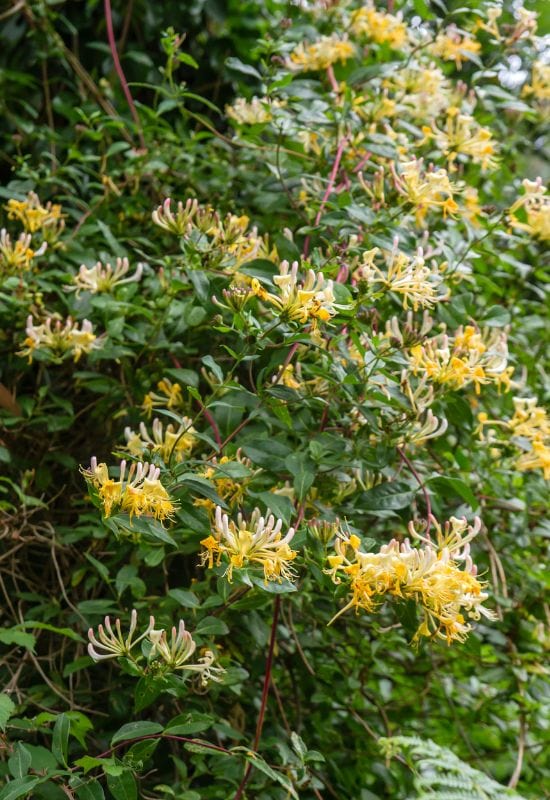
You could grow the more popular yellow honeysuckle (Lonicera flava), but I suggest you also look at the lesser known ‘Halliana’ Japanese honeysuckle… While the first gives you golden and bright orange even red, the latter (Lonicera japonica ‘Halliana’) stays within the yellow range, but with softer tones…
The blossoms start off on the blonde to flaxen range, but they slowly pale as they mature, to butter and then cream… This variety also has longer petals at the mouth, which open wide and turn back more than with its sisters.
So, one is best for stronger, more vibrant blooms, the other for a more elegant and soft display. However, both will give you light whorls of tubular blossoms that attract lots of butterflies and hummingbirds and very fragrant.
But while L. flava will stop by the end of spring, L. japonica can keep going to October! Fast growing and vigorous these people twining climbers also produce very lush, mid green and elliptic leaves as a fresh backdrop to their floral displays.
So, you have two varieties of yellow blossoming honeysuckle for your walls, trellis or pergola, and you can pick the one that best suits your needs, one gives you a bright, strong and vibrant yellow burst for a short time, the other a gentle light that fades into the twilight.
11: Canary Creeper (Senecio tamoides)
Native of South Africa, canary creeper has a very temperate look and personality, and brightly so. This creeping or climbing vine has become a decorative variety now, but in its natural habitat it grows on escarpments and on the margins of forests, where it clings to trees and drapes them.
Of course, it has yellow blooms, in a bright golden tonality, and they are perfect for a late season display, as they come from the end of summer to the middle of fall… It will produce abundant round clusters of star shaped flowers, each being small, but with a huge overall effect.
Actually, if you look closely at the blossoms, you may notice a similarity to another famous flowering plant: in fact, the blooms are quite similar to daisies with few petals… An unusual property they have is that they exude a strong cinnamon fragrance…
Fast growing and strong, it then produces fluffy pappi, like dandelions, for a fluffy end of the year! The evergreen foliage is reminiscent of ivy, with palmate and broad, large and veined, rich green leaves, about 3 inches across (7.5 cm).
Despite its exotic origin, canary creeper will also suit traditional, temperate looking gardens on walls or pergolas, and even to scramble on slopes to stop soil erosion, and its yellow blooms and foliage will work well also in a naturalized area.
12: Yellow Fence Morning Glory (Ipomoea ochracea)
And we a morning glory variety could not be absent from our Sun colored list. And you may know many varieties in white, purple, violet and blue… But there is a lesser known one that’s called yellow fence morning glory for a reason.
In fact, this twining vine native of tropical and subtropical Africa will produce the typical funnel shaped, broad blossoms of thus genus, with joined up petals, and about 1.5 inches across (4.0 cm).
And it will do it for an extremely long season indeed, from early fall all the way to late spring! And yes, it does mean that it will be in full bloom in winter!
The exact color may vary a bit, from bright yellow to pale canary, even lemon or pineapple, and, at the very center of each flower, you will see a very dark, almost black point, like a central button.
The leaves are typically hear shaped, big and mid to dark green in color, with a semi glossy upper page and glaucous undersides.
Grown as a climber or as a creeper, yellow fence morning glory will hold on to light trellises, even wire fences, or protect slopes and banks from erosion; fast growing but light, it will give you its blossoms for months on end even when sunlight is low!
13: Yellow Nasturtium (Tropaeolum majus)
Native of Central and South America, nasturtium is a really useful climber (or creeper, if you wish)! And it does have yellow in its blossoms, but also red and orange…
Still, let’s see why it is exceptional… To start with, it is an annual… for this reason, you can grow it in any climate zone, and it will give its best in a single year, growing to its full size and blooming…
Yes, all the way from early summer to fall, even late in warm regions… Easy to grow, it will open lovely, round mouthed trumpet shaped flowers, about 2 inches across (5.0 cm).
What is more, in warmer countries, it is actually a perennial, so you can keep it over the winter season as well…
The leaves are rally attractive and lush too… Bright green to bluish, they look soft and fresh, and they have an unusual shape: they are orbicular (or peltate)… And this means that they are round, but the petiole attaches in the middle of them, like a shield. And finally, both blossoms and foliage are edible!
A really sweet looking (and sweet tasting) vine with lots of yellow flowers, nasturtium is a classic in Mediterranean gardens, where it is grown as a perennial, as a climber, but also as ground cover, and if you want the same effect in a cold garden – just treat it as an annual!
14: Black Eyed Susan Vine (Thunbergia alata)
This climber shares part of its name with a famous sunny perennial, Rudbeckia for botanists, and for a reason… You will find thus reason at the very center of black eyed Susan vine, where a round black (really dark purple) spot looks like a pupil…
All around it the flat petals form a lovely blossom, with their gently dented margin, and they reach about 2 inches across (5.0 cm).
The flowers will come from early summer, and they will not stop opening till fall… Now, let’s come to the color… It can be strong golden yellow or sometimes much more on the orange side.
You may like to take the risk, but if you want to stay in the safe side, there is a cultivar, sweetly called ‘Yellow Suzie’, which will guarantee you a bright canary tonality, sometimes even paling to pineapple shades.
Fast growing, it will soon produce a canvas of evergreen, semi glossy and rich green canvas of leaves where it will scatter its beautiful blossoms.
Black eyed Susan vine is a tender climber, but it does have an edge, even an advantage over most other exotic varieties… It grows so fast over your fence, walls or arbor, that many gardeners grow it as an annual!
15: Cat’s Claw Trumpet Vine (Macfadyena Unguis-Cati)
I have kept a little surprise for last… If you have read our articles before, you will know that we don’t stick to common varieties, we look around, we search… and we have found a really decorative climbing vine from Central and South American forests, where it clings on to tall trees… Its blossoms are trumpet shaped, like others we have seen so far, but they open to such large mouths that they almost look like butterflies.
With round petals, they form “lips” and a “mouth” of about 2 inches across (5.0 cm) and 3.3 inches long (8.0 cm), coming in terminal clusters of up to three and individually.
Their color is usually of the most luminous golden yellow you will ever see, but sometimes they take on a blonde tonality…This floral display will last for an incredibly long time, from late summer to mid winter, in fact!
They are followed by brown flattened capsules that can contain up to 200 seeds each… Technically a liana, it has semi evergreen foliage in rich emerald green and with lovely opposite elliptic to lance shaped leaves.
Cat’s claw trumpet vine may be a collector’s item for an exotic garden, but if you live in a hot and humid region, you may well give it a try and it will certainly make you a little gardening personality in your neighborhood…
Sunny Yellow Blossoms Draping Walls, Trellises, Fences on Climbing Vines!
We have come to the end of this journey! True, most varieties of vines with blooms in brilliant shades of yellow are exotic climbers, but there are also some cold hardy ones, as you can see. But one thing they all share: the vibrant energy and light of the Sun itself!

Written By
Amber Noyes
Amber Noyes was born and raised in a suburban California town, San Mateo. She holds a master’s degree in horticulture from the University of California as well as a BS in Biology from the University of San Francisco. With experience working on an organic farm, water conservation research, farmers’ markets, and plant nursery, she understands what makes plants thrive and how we can better understand the connection between microclimate and plant health. When she’s not on the land, Amber loves informing people of new ideas/things related to gardening, especially organic gardening, houseplants, and growing plants in a small space.

